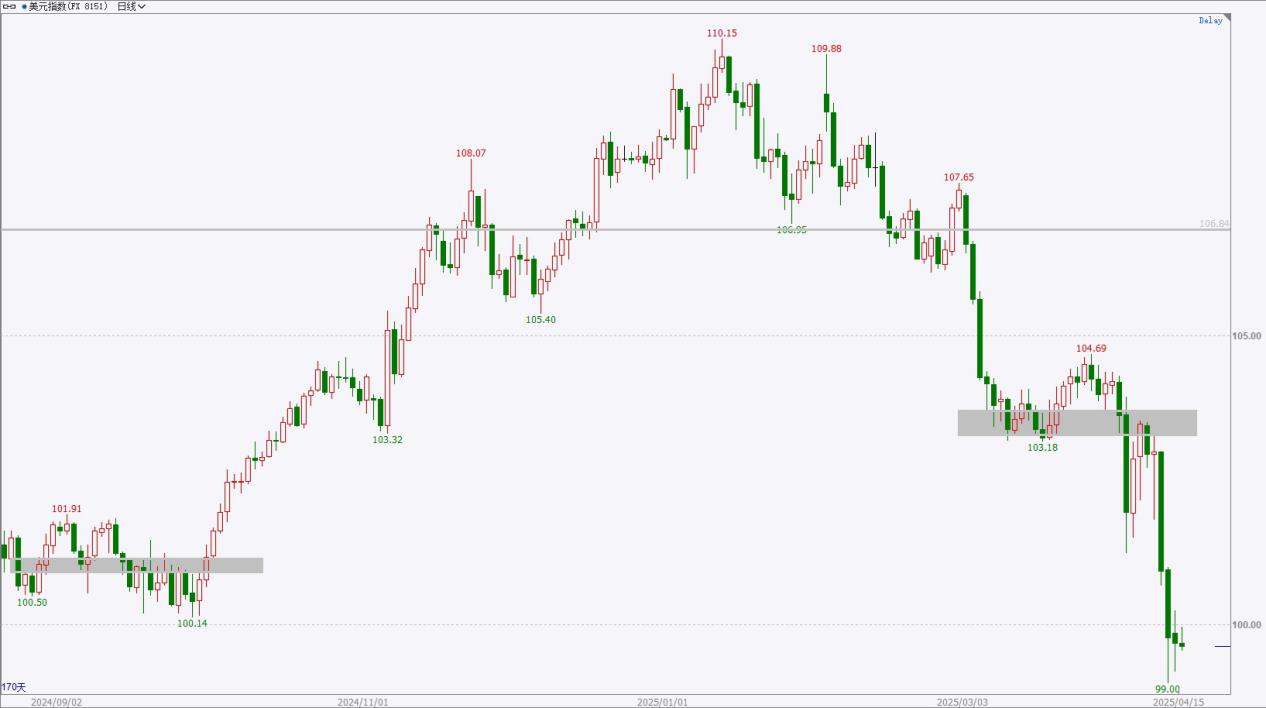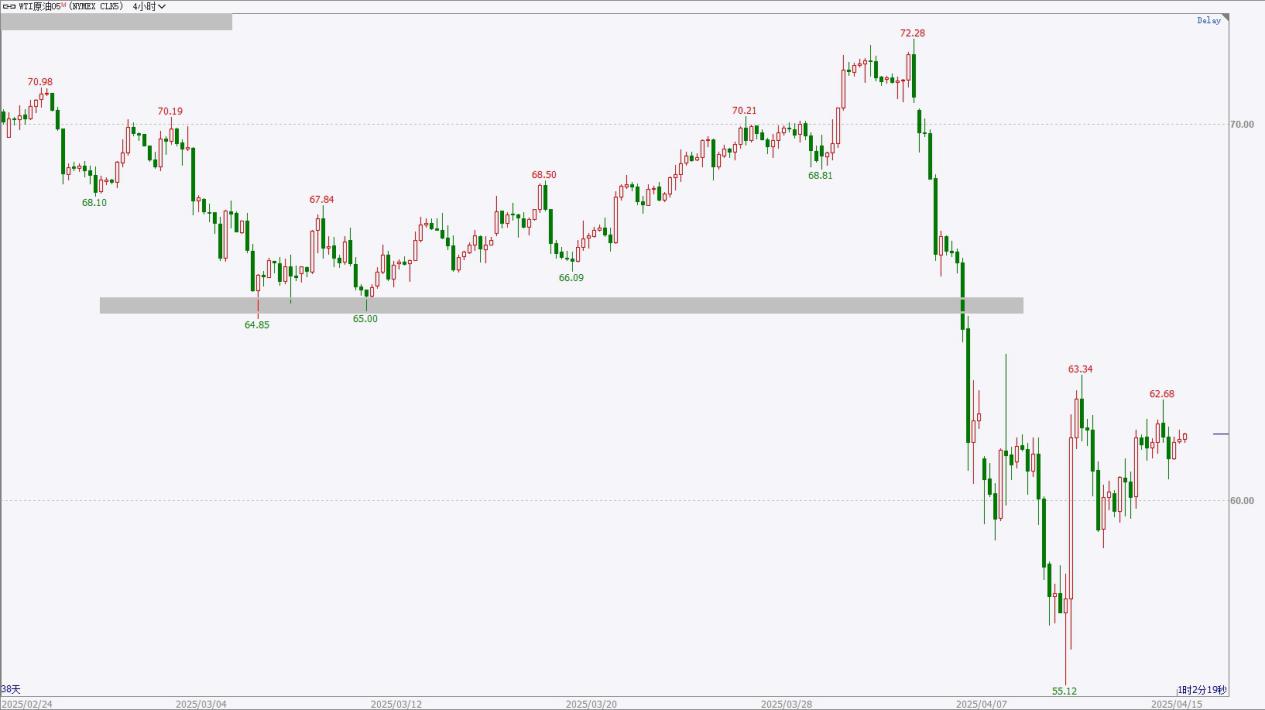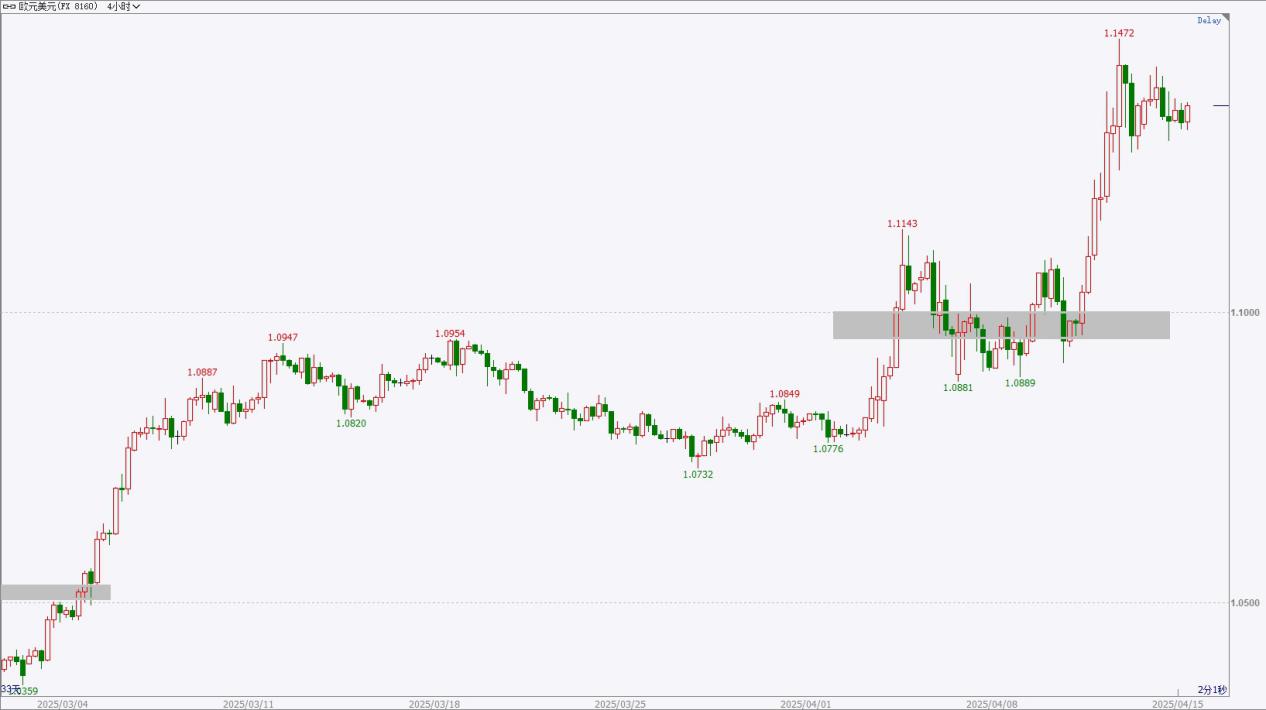|
Time
|
Data and Events
|
Importance
|
|
09:30
|
The Reserve Bank of Australia releases the minutes of the April monetary policy meeting
|
★★★
|
|
14:00
|
UK February three-month ILO unemployment rate
|
★★★
|
|
UK March unemployment rate
|
★★★
|
|
UK March jobseeker benefits applicants
|
★★★
|
|
14:45
|
France March CPI final monthly rate
|
★★★
|
|
16:00
|
IEA releases monthly oil market report
|
★★★
|
|
17:00
|
Germany April ZEW Economic Sentiment Index
|
★★★
|
|
Eurozone April ZEW Economic Sentiment Index
|
★★★
|
|
Eurozone February industrial production monthly rate
|
★★★
|
|
20:30
|
Canada March CPI monthly rate
|
★★★
|
|
US April New York Fed Manufacturing Index
|
★★★
|
|
US March import price index monthly rate
|
★★★
|
|
Next day
00:00
|
ECB President Lagarde and European Council President Costa hold an informal dinner and exchange views
|
★★★
|
|
Variety
|
Perspective
|
Support range
|
Resistance range
|
|
US Dollar Index
|
Slightly weaker
|
99-100
|
103-104
|
|
Gold
|
Slightly stronger
|
3100-3130
|
3250-3260
|
|
Crude Oil
|
Short-term rebound
|
56-57
|
62-63
|
|
Euro
|
Slightly stronger
|
1.0950-1.1000
|
1.1450-1.1500
|
*Pre-market views are time-sensitive and limited, are purely speculative, and are for reference and learning only; they do not constitute investment advice, and all operating risks are borne by the individual. Investment carries risks; trading requires caution.
Fundamental Analysis:
In the March meeting, the Fed kept interest rates unchanged, the labor market remained robust, and raised inflation expectations for the next two years while lowering the GDP growth forecast for the next three years. Starting in April, the pace of balance sheet reduction will slow, and there is uncertainty in tariff policy. In March, the non-farm payroll data showed an addition of 228,000 jobs, far exceeding expectations, but the unemployment rate slightly increased, indicating a strong labor market. Tariff policies add market risks and uncertainties. The seasonally adjusted CPI in March showed a slight year-over-year decrease, leading to rising expectations for rate cuts in the future.
Technical Analysis:

The US Dollar Index experienced slight fluctuations yesterday, closing with a small real body candlestick on the daily chart. The short-term trend is slightly choppy, currently near the support zone, and it is inadvisable to excessively chase short positions. A rebound or fluctuation may occur in the short term; attention should be paid to signs of a bottoming out. Overall, prices have retreated from highs, broken through important support zones, and have yet to show stabilizing signs. The resistance zone is near 103-104, while the support zone is around 99-100.
Viewpoint: Slightly weaker, with prices nearing the support zone; the short-term may experience fluctuations or rebounds.
*Pre-market views are time-sensitive and limited, are purely speculative, and are for reference and learning only; they do not constitute investment advice, and all operating risks are borne by the individual. Investment carries risks; trading requires caution.
Fundamental Analysis:
The geopolitical conflict in the Middle East continues to worsen, and the Eastern European situation remains uncertain in the short term. In early March, the ECB decided to cut interest rates by 25 basis points for the fifth consecutive time, with inflation progressing smoothly while risks to economic growth skewed downwards. In the March Fed rate decision, rates were maintained unchanged, with a firm labor market and lower GDP growth expectations, indicating a slowdown in the rate of balance sheet reduction. The US March non-farm payroll data showed a significant increase in jobs beyond expectations, with a slight rise in unemployment; the March CPI year-on-year showed a slight decrease, raising Fed rate cut expectations; the US tariff policy may stimulate the safe-haven nature of gold.
Technical Analysis:

The gold price slightly fell yesterday, with small cycle oscillation and adjustment. There may be selling pressure above, so it’s not advisable to chase upward excessively. In the short term, there might be more fluctuations. If there is a long position, consider reducing holdings to take profits at high points and be cautious of the risk of a short-term market correction. From a larger cycle perspective, the upward structure is maintained, with a significant rise in the daily line and a new high, showing no signs of weakening. The upper pressure level is around 3250-3260, and the lower support level is around 3100-3130.
Viewpoint: Oscillating with a slight upward bias; pay attention to previous high pressure levels and consider taking profits at high points if there are long positions.
*Pre-market views are time-sensitive and limited, are purely speculative, and are for reference and learning only; they do not constitute investment advice, and all operating risks are borne by the individual. Investment carries risks; trading requires caution.
Fundamental Analysis:
The April EIA monthly report maintains the oil production forecasts for this year and next year, with a slight downward adjustment of global oil demand for these two years. The OPEC monthly report slightly lowers the expected global economic growth rate for this year and next year, as well as the expected growth of global oil demand. At the beginning of April, the OPEC+ ministerial meeting decided to maintain the oil production policy unchanged and agreed to unexpectedly increase production in May. There is uncertainty surrounding U.S. tariff policies, which may affect demand. EIA crude oil inventory increased by 2.55 million barrels, reflecting a relatively loose supply and demand structure.
Technical Analysis:

U.S. crude oil experienced slight fluctuations yesterday, with limited volatility and prices at relatively low levels, showing signs of slowing down in the decline and possibly indicating a rebound trend. Focus on signals for a second retest and stabilization, and consider short-term low-buy opportunities to take profits timely, while also paying attention to whether the pressure level can be broken. Overall, oil has performed relatively weakly lately, with prices significantly oversold, showing no signs of large-scale stabilization yet. The upper pressure area is around 62-63, while the lower support area is around 56-57.
Viewpoint: Short-term rebound; focus on stabilization signals and consider short-term long opportunities.
*Pre-market views are time-sensitive and limited, are purely speculative, and are for reference and learning only; they do not constitute investment advice, and all operating risks are borne by the individual. Investment carries risks; trading requires caution.
Fundamental Analysis:
The European Central Bank’s interest rate decision in early March resulted in the fifth consecutive 25 basis point rate cut. The progress of inflation reduction is smooth, with a slight downward adjustment of GDP growth rate expectations for this year and next year, and economic growth risks are skewed to the downside. The Federal Reserve’s March rate decision was to maintain rates unchanged, raising inflation expectations while lowering GDP growth rate expectations, and slowing the pace of balance sheet reduction. In March, U.S. non-farm payroll data showed employment numbers significantly exceeding expectations, while the unemployment rate rose slightly; the March CPI year-over-year decreased slightly. In the Eurozone and major economies like France and Germany, the manufacturing PMI values were slightly better than previous and expected values.
Technical Analysis:

The euro price experienced slight fluctuations during the day, with small cycles making multiple attempts to push higher but failing to make significant new highs. Be cautious of the risk of a market correction, and in the short term, the main strategy remains to buy on dips while taking profits at high points, while also monitoring if prices can reach new highs. Overall, the large cycle’s upward structure is intact, showing no signs of weakening. The upper pressure area is around 1.1450-1.1500, and the lower support area is around 1.0950-1.1000.
Viewpoint: Oscillating with a slight upward bias; in the short term, maintain a buy-on-dips approach while taking profits at high points.
*Pre-market views are time-sensitive and limited, are purely speculative, and are for reference and learning only; they do not constitute investment advice, and all operating risks are borne by the individual. Investment carries risks; trading requires caution.


Daily Reviews
Our award-winning team of analysts provides keen and insightful technical and fundamental analysis to understand daily market news and investment trading opportunities
HTFX Daily Forex Commentary 0415
Time
Data and Events
Importance
09:30
The Reserve Bank of Australia releases the minutes of the April monetary policy meeting
★★★
14:00
UK February three-month ILO unemployment rate
★★★
UK March unemployment rate
★★★
UK March jobseeker benefits applicants
★★★
14:45
France March CPI final monthly rate
★★★
16:00
IEA releases monthly oil market report
★★★
17:00
Germany April ZEW Economic Sentiment Index
★★★
Eurozone April ZEW Economic Sentiment Index
★★★
Eurozone February industrial production monthly rate
★★★
20:30
Canada March CPI monthly rate
★★★
US April New York Fed Manufacturing Index
★★★
US March import price index monthly rate
★★★
Next day
00:00
ECB President Lagarde and European Council President Costa hold an informal dinner and exchange views
★★★
Variety
Perspective
Support range
Resistance range
US Dollar Index
Slightly weaker
99-100
103-104
Gold
Slightly stronger
3100-3130
3250-3260
Crude Oil
Short-term rebound
56-57
62-63
Euro
Slightly stronger
1.0950-1.1000
1.1450-1.1500
*Pre-market views are time-sensitive and limited, are purely speculative, and are for reference and learning only; they do not constitute investment advice, and all operating risks are borne by the individual. Investment carries risks; trading requires caution.
Fundamental Analysis:
In the March meeting, the Fed kept interest rates unchanged, the labor market remained robust, and raised inflation expectations for the next two years while lowering the GDP growth forecast for the next three years. Starting in April, the pace of balance sheet reduction will slow, and there is uncertainty in tariff policy. In March, the non-farm payroll data showed an addition of 228,000 jobs, far exceeding expectations, but the unemployment rate slightly increased, indicating a strong labor market. Tariff policies add market risks and uncertainties. The seasonally adjusted CPI in March showed a slight year-over-year decrease, leading to rising expectations for rate cuts in the future.
Technical Analysis:
The US Dollar Index experienced slight fluctuations yesterday, closing with a small real body candlestick on the daily chart. The short-term trend is slightly choppy, currently near the support zone, and it is inadvisable to excessively chase short positions. A rebound or fluctuation may occur in the short term; attention should be paid to signs of a bottoming out. Overall, prices have retreated from highs, broken through important support zones, and have yet to show stabilizing signs. The resistance zone is near 103-104, while the support zone is around 99-100.
Viewpoint: Slightly weaker, with prices nearing the support zone; the short-term may experience fluctuations or rebounds.
*Pre-market views are time-sensitive and limited, are purely speculative, and are for reference and learning only; they do not constitute investment advice, and all operating risks are borne by the individual. Investment carries risks; trading requires caution.
Fundamental Analysis:
The geopolitical conflict in the Middle East continues to worsen, and the Eastern European situation remains uncertain in the short term. In early March, the ECB decided to cut interest rates by 25 basis points for the fifth consecutive time, with inflation progressing smoothly while risks to economic growth skewed downwards. In the March Fed rate decision, rates were maintained unchanged, with a firm labor market and lower GDP growth expectations, indicating a slowdown in the rate of balance sheet reduction. The US March non-farm payroll data showed a significant increase in jobs beyond expectations, with a slight rise in unemployment; the March CPI year-on-year showed a slight decrease, raising Fed rate cut expectations; the US tariff policy may stimulate the safe-haven nature of gold.
Technical Analysis:
The gold price slightly fell yesterday, with small cycle oscillation and adjustment. There may be selling pressure above, so it’s not advisable to chase upward excessively. In the short term, there might be more fluctuations. If there is a long position, consider reducing holdings to take profits at high points and be cautious of the risk of a short-term market correction. From a larger cycle perspective, the upward structure is maintained, with a significant rise in the daily line and a new high, showing no signs of weakening. The upper pressure level is around 3250-3260, and the lower support level is around 3100-3130.
Viewpoint: Oscillating with a slight upward bias; pay attention to previous high pressure levels and consider taking profits at high points if there are long positions.
*Pre-market views are time-sensitive and limited, are purely speculative, and are for reference and learning only; they do not constitute investment advice, and all operating risks are borne by the individual. Investment carries risks; trading requires caution.
Fundamental Analysis:
The April EIA monthly report maintains the oil production forecasts for this year and next year, with a slight downward adjustment of global oil demand for these two years. The OPEC monthly report slightly lowers the expected global economic growth rate for this year and next year, as well as the expected growth of global oil demand. At the beginning of April, the OPEC+ ministerial meeting decided to maintain the oil production policy unchanged and agreed to unexpectedly increase production in May. There is uncertainty surrounding U.S. tariff policies, which may affect demand. EIA crude oil inventory increased by 2.55 million barrels, reflecting a relatively loose supply and demand structure.
Technical Analysis:
U.S. crude oil experienced slight fluctuations yesterday, with limited volatility and prices at relatively low levels, showing signs of slowing down in the decline and possibly indicating a rebound trend. Focus on signals for a second retest and stabilization, and consider short-term low-buy opportunities to take profits timely, while also paying attention to whether the pressure level can be broken. Overall, oil has performed relatively weakly lately, with prices significantly oversold, showing no signs of large-scale stabilization yet. The upper pressure area is around 62-63, while the lower support area is around 56-57.
Viewpoint: Short-term rebound; focus on stabilization signals and consider short-term long opportunities.
*Pre-market views are time-sensitive and limited, are purely speculative, and are for reference and learning only; they do not constitute investment advice, and all operating risks are borne by the individual. Investment carries risks; trading requires caution.
Fundamental Analysis:
The European Central Bank’s interest rate decision in early March resulted in the fifth consecutive 25 basis point rate cut. The progress of inflation reduction is smooth, with a slight downward adjustment of GDP growth rate expectations for this year and next year, and economic growth risks are skewed to the downside. The Federal Reserve’s March rate decision was to maintain rates unchanged, raising inflation expectations while lowering GDP growth rate expectations, and slowing the pace of balance sheet reduction. In March, U.S. non-farm payroll data showed employment numbers significantly exceeding expectations, while the unemployment rate rose slightly; the March CPI year-over-year decreased slightly. In the Eurozone and major economies like France and Germany, the manufacturing PMI values were slightly better than previous and expected values.
Technical Analysis:
The euro price experienced slight fluctuations during the day, with small cycles making multiple attempts to push higher but failing to make significant new highs. Be cautious of the risk of a market correction, and in the short term, the main strategy remains to buy on dips while taking profits at high points, while also monitoring if prices can reach new highs. Overall, the large cycle’s upward structure is intact, showing no signs of weakening. The upper pressure area is around 1.1450-1.1500, and the lower support area is around 1.0950-1.1000.
Viewpoint: Oscillating with a slight upward bias; in the short term, maintain a buy-on-dips approach while taking profits at high points.
*Pre-market views are time-sensitive and limited, are purely speculative, and are for reference and learning only; they do not constitute investment advice, and all operating risks are borne by the individual. Investment carries risks; trading requires caution.
Latest Reviews
HTFX Daily Forex Commentary 0819
HTFX Daily Forex Commentary 0815
HTFX Daily Forex Commentary 0812
HTFX Daily Forex Commentary 0811
Choose a Trusted Broker for Trading
Over 300 employees worldwide, more than 1,000 products, top-tier liquidity